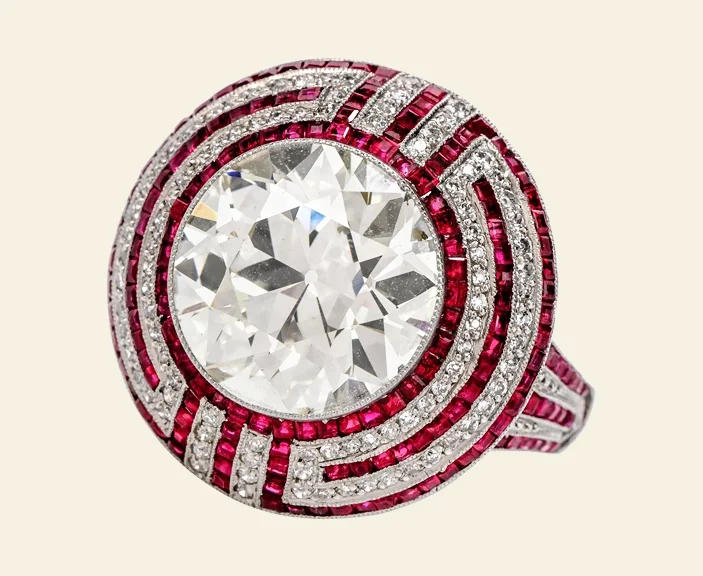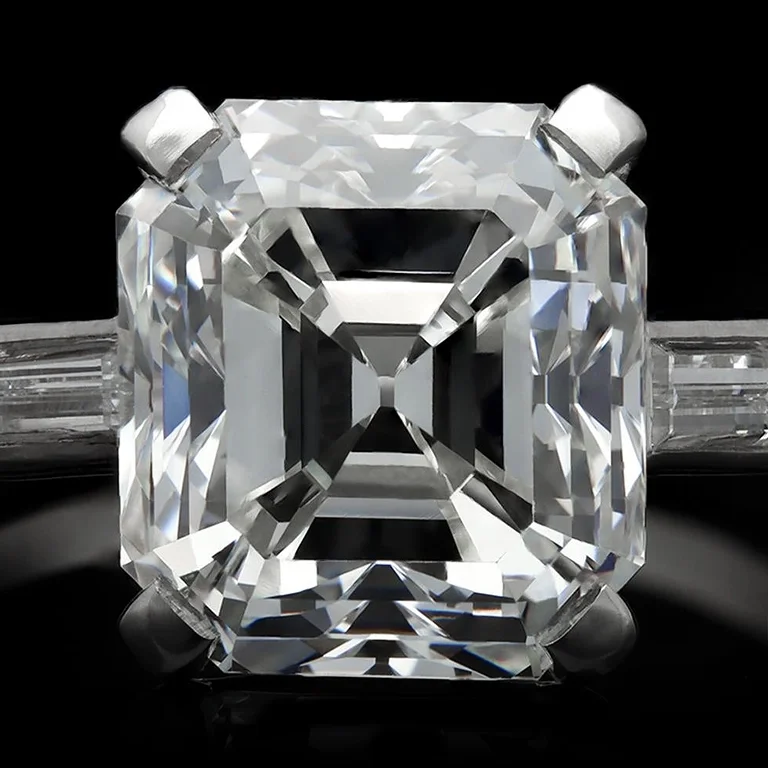The 1stDibs Art Deco Engagement Rings Buying Guide
The Art Deco movement made an indelible mark on all fields of design throughout the 1920s and ’30s. It was marked by a period of social, political and technological revolution and the design aesthetic of the time was fittingly bold and beautiful. The modern spirit of the Roaring Twenties shaped Art Deco jewelry, which is characterized by symmetrical forms, unconventional geometries and luxurious materials. Glamorous and dazzling, Art Deco engagement rings have had a resurgence in recent years.
Origins of the Art Deco Era
After the end of World War I and the rise of industrialization, there were shifts in culture, art and society across Europe and North America.
The stuffy formalities of the previous Belle Époque and Edwardian eras gave way to new social freedoms. Dating replaced Victorian-era courtship rituals, and people married for love instead of simply fulfilling familial obligations. Jazz clubs, not churches, were venues for socializing. High heels, short skirts and Art Deco jewelry were emblematic of women’s new sense of self and individualism.
Art Deco engagement rings are the oldest of what is considered to be vintage engagement rings and will soon be considered antiques.
An Art Deco platinum and diamond engagement ring, offered by hawkantiques.
Art Deco Engagement Ring Styles
The allure of these designs lies in their distinctive style. Art Deco engagement rings combine the timeless elegance of a rectangular or square-cut diamond with an emphasis on streamlined shapes and symmetrical patterns surrounding the center stone. Colorful gemstones often encircle the stone, creating a striking contrast to the era’s so-called “white settings” in platinum and white gold.
An Art Deco diamond and ruby engagement ring, offered by Dover Jewelry.
Geometric Shapes and Symmetry
A fascination with geometric forms in visual culture informs the Art Deco style.
Jewelry of the Art Deco period is sculptural, inspired by revolutionary art movements like Cubism, Futurism and the Machine Aesthetic, sometimes called Precisionism. Sleek lines, precise angles and simple shapes in symmetrical patterns make for a noticeable departure from the oval and round diamonds favored in engagement rings of the previous eras.
An Art Deco sapphire and diamond engagement ring, offered by Baume.
Colorful Gemstones
The diamond is often thought of as the solitary centerpiece of an Art Deco engagement ring, but, while the era represented a continuation of the Edwardian period’s white-on-white look (with platinum or white gold joined by diamonds), these ultra-cherished gemstones were also used to pave areas around the shank and central diamond.
Arranged in symmetrical patterns around the center stone, accent gems such as sapphires, emeralds and rubies brought vivid color to engagement rings and added sophistication and glamour. The superior quality of the lavish rings of this period makes them beloved heirlooms that can be passed down from generation to generation, to have and to hold for all time.
Notice the way the buffed onyx accentuates the bezel-set old European-cut diamond in the center of this 1920s-era Art Deco engagement ring. Offered by Estate Diamond Jewelry.
Bold Designs with Black Onyx
Art Deco jewelers regularly used onyx or black enamel to complement diamonds in unique engagement ring designs, as seen in this European-cut diamond engagement ring made in 1925.
Because of its luster and stark appearance, black onyx is the focus of many Art Deco rings. While onyx was often incorporated in the mourning jewelry of the Victorian period, designers also used the material in jewelry for all occasions due to its bold look and sleek surface.
This 1920s diamond engagement ring features an old European-cut stone surrounded by pavé diamonds and delicate filigree. Offered by AC Silver.
Art Deco Milgrain and Filigree
Milgrain and filigree work on Art Deco engagement rings added a decorative touch to the angular, symmetrical metalwork that so frequently characterized the jewelry of the period.
Derived from the French word for “a thousand grains,” milgrain refers to a design technique that is used to add a layer of delicate pebble-like detailing along the edges of ring settings. Milgrain brings refinement and elegance to Art Deco engagement rings. It requires close scrutiny to observe all of this meticulous workmanship. Tiny beads run along the gemstones and down the shank of the ring, adding ornamental texture that enhances the design and helps draw the eye to the ring’s key features.
An ancient technique that existed long before it was popularized during the Edwardian era, filigree was commonly used during the Art Deco era owing to the period’s advances in materials and technology. Brooches, cocktail rings and engagement rings demonstrate how the hand-soldering of filigree was replaced by die-cast machinery.
Art Deco engagement rings featuring filigree are marked by extraordinary attention to detail. Platinum was the metal of choice for these lacy designs. Filigree adds a graceful lightness to a ring and complements geometric gemstones.
A French Art Deco diamond engagement ring, offered by Baume.
Common Art Deco Ring Settings
An Art Deco engagement ring is a symbol of love with a powerful presence. During this period, engagement ring settings, which hold the gemstones in place, ranged from traditional prongs to modern bezels. Jewelers perfected dramatic gemstone settings that complemented and elevated the era’s geometric designs.
Four-prong setting
This setting draws the eye to the center gemstone. Its minimalist approach showcases the size, color and brilliance of the stone by maximizing light exposure from every angle.
Bezel setting
A sleek, modern design in which the center stone is framed by a metal border, this setting enhances the stone’s beauty and provides additional protection.
Pavé setting
Gemstones that are closely set together create a setting that looks like it’s paved with a glimmering surface.
Halo setting
In this setting, a circle of smaller gemstones, often diamonds, surrounds a larger center stone with a sparkly halo. It adds an extra element of glittering detail to complement the brilliance of the center stone.
Art Deco Diamond Cuts
In Art Deco jewelry, diamonds often take center stage. Combined with bold geometries, their radiance captures the flamboyant spirit of the Roaring Twenties. The new diamond-cutting technologies of the time produced sleek, precise lines and angles.
Thanks to their brilliance and masterful craftsmanship, it’s no surprise that Art Deco diamond rings are enjoying a renaissance. Popular cuts include:
Step cut: This family of cuts features rectangular facets. They look like steps climbing up the sides of the crown of the diamond. Popular Art Deco step cuts include the emerald cut and the baguette cut.
Asscher cut: This is another step cut that was popularized during the Art Deco era. It is square, unlike the rectangular emerald and baguette cuts.
Carré cut: A square cut with step facets, the carré checks all the boxes of classic Art Deco engagement ring design: geometric lines, sharp angles and rich lustre.
A 1920s Art Deco engagement ring featuring an Asscher cut sapphire at its center, wrapped in a border of old European-cut diamonds. Offered by Farringdons.
The 4Cs
Regardless of the exact date your Art Deco engagement ring was created, there is an official grading system used to indicate the value of the diamond.
Diamonds are always graded according to the universal 4Cs grading system that was established by the Gemological Institute of America (GIA). The 4Cs — color, clarity, cut and carat weight — allow buyers around the world to know the precise quality of the diamond they are purchasing.
Color
The color of a diamond is graded on a scale ranging from D, which means it’s completely colorless, to Z, which means it has a yellow or brown tinge.
Clarity
A gemstone is examined under a microscope to check for inclusions and flaws that are often too small to see with the naked eye. The more transparent and pure a diamond, the higher its value. Clarity grades range from “included” (I) and “slightly included” (SI) diamonds to “very, very slightly included” (VVS) and “internally flawless” (IF).
Cut
Looking for maximum sparkle? The cut grade evaluates how well a diamond’s facets reflect the light on any cut, from “excellent,” the highest grade, to “poor,” the lowest.
Carat
The weight of a diamond is measured in carats. One carat equals 200 milligrams (one-fifth of a gram). Most diamonds range from 0.25 to 0.5 carats. Carat differs from size; two diamonds may weigh the same, but the shape, cut and quality can differ, making one appear larger than the other.
Personal taste, style and budget all come into consideration when you shop for an Art Deco engagement ring.
A Cartier Art Deco diamond engagement ring, offered by Berganza.
Art Deco Influence and Influencers
In the early 20th century, archaeological finds in Egypt and Central America — the excavation of King Tut’s tomb, the investigation of ancient Mayan sites — heavily influenced and inspired Art Deco jewelers, artists and designers with incredible architectural forms and eclectic motifs. Industrialization, new capabilities and modern technology also inspired the era’s gemstone cuts, settings and overall ring designs.
Icons of the era, like Greta Garbo and Marlene Dietrich, wore stunning Art Deco engagement rings with large, emerald-cut diamonds surrounded by geometric designs made with smaller diamonds. These gorgeous rings, and the women who wore them, captivated couples seeking to emulate Hollywood glamour.
Renowned jewelry houses created Art Deco engagement rings that had a lasting influence and endure in popularity today. Cartier emerged as a true pioneer of Art Deco jewelry with a vision that embraced modernity. Cartier engagement rings stood for luxury and elegance during the Art Deco era and continue to epitomize that today.
Cartier introduced platinum in luxury jewelry during the 1800s and the precious metal later became closely associated with the Art Deco era. Platinum’s superior strength allowed Cartier’s expert artisans to create tantalizing designs and complex settings that defined the Art Deco trend with crisp configurations of diamonds and colored gemstones. In short, it set the standard for sophistication and creativity in fine jewelry.
Art Deco engagement rings by Van Cleef & Arpels feature intricate filigree work and gemstones in high-contrast color combinations and mesmerizing patterns. The iconic luxury house’s visionary creations captured the essence of the Art Deco era in geometric pieces that display a balance of elegance and modernity. Van Cleef & Arpels engagement rings from this period are highly sought-after today by collectors and couples alike.
Boucheron also brought innovative jewelry designs to the Art Deco era. Its creations featured a daring sense of modernity expressed in vibrant gemstones, diamonds and hard-edged lines. These elements seamlessly blended with the timeless luxury of Boucheron’s captivating metalwork and engravings. The house’s engagement rings capture the spirit of the Art Deco period, then and now.
The pair of arrowheads balanced on scrolls on this 1930s Art Deco engagement ring is a testament to the archaeological influence on early 20th-century jewelry. Offered by Baume.
Art Deco’s Timeless Beauty
Ready to search for a ring that captures your imagination and speaks to your heart? Art Deco engagement rings are the perfect marriage of history, character and enduring beauty. Whether you are entranced by the exuberant colors in a mixed-gemstone setting, clean geometric lines or the refined milgrain and filigree designs, a compelling array of Art Deco engagement rings awaits you on 1stDibs.












